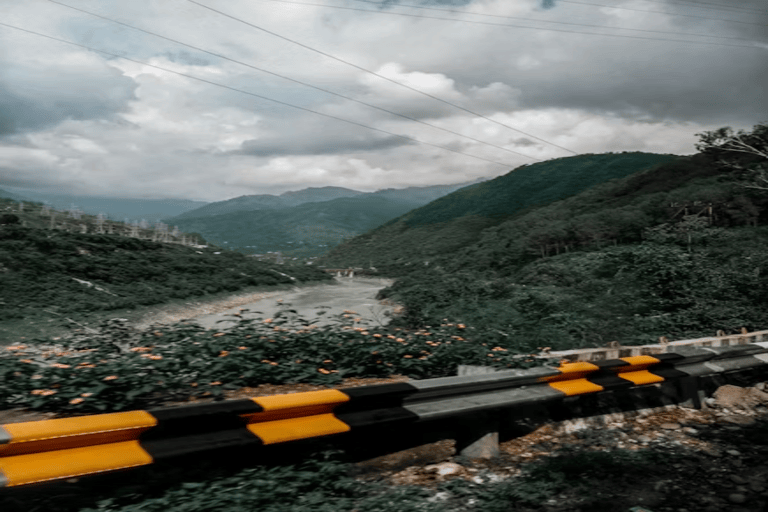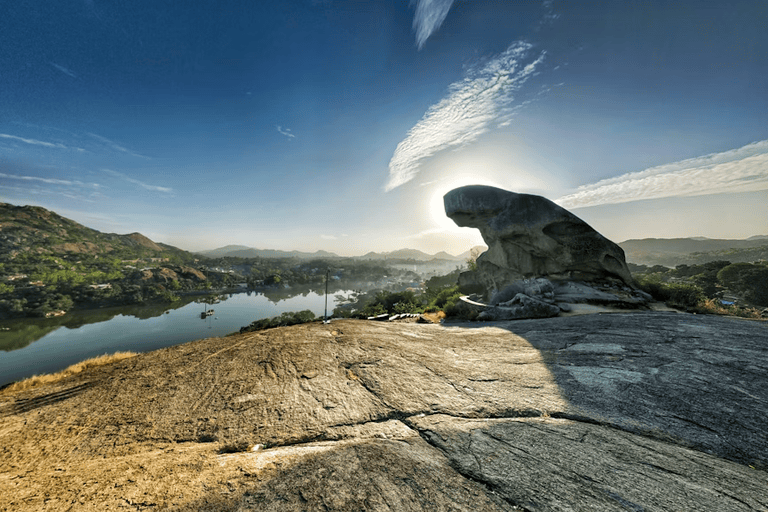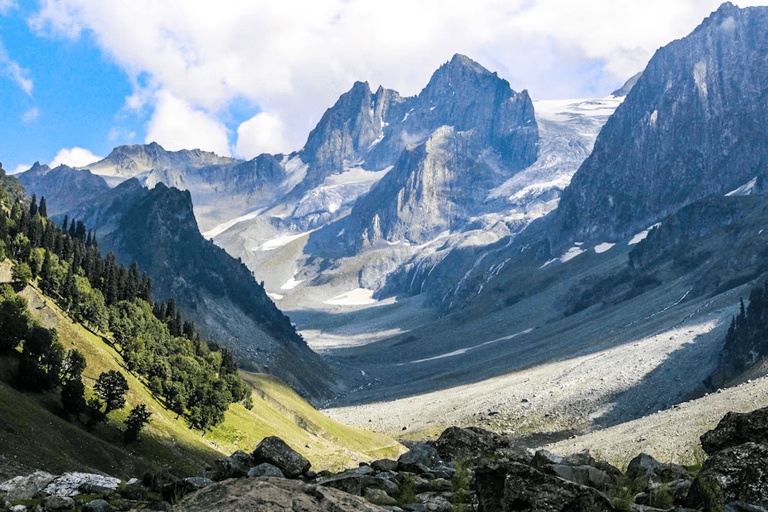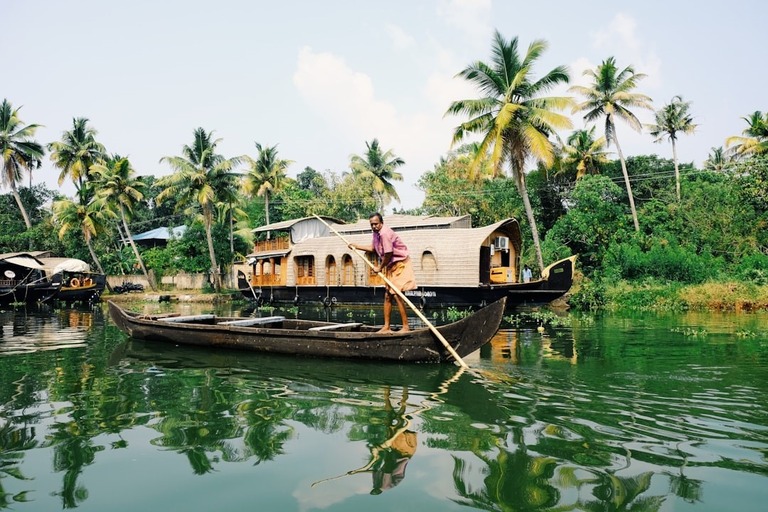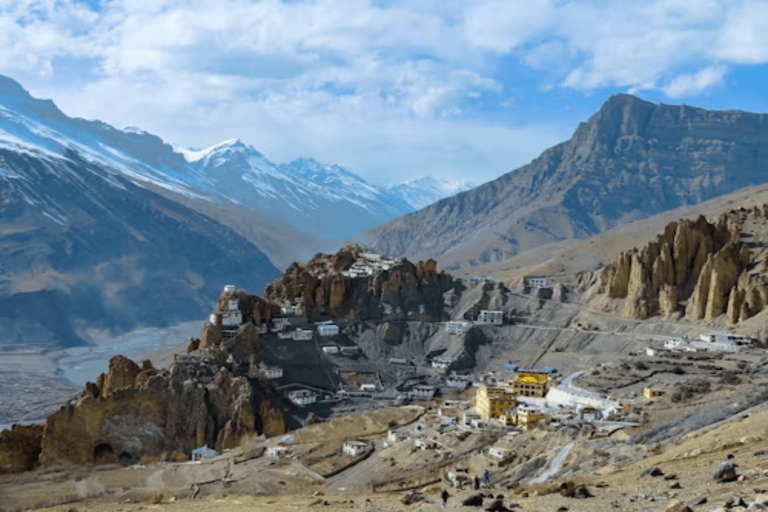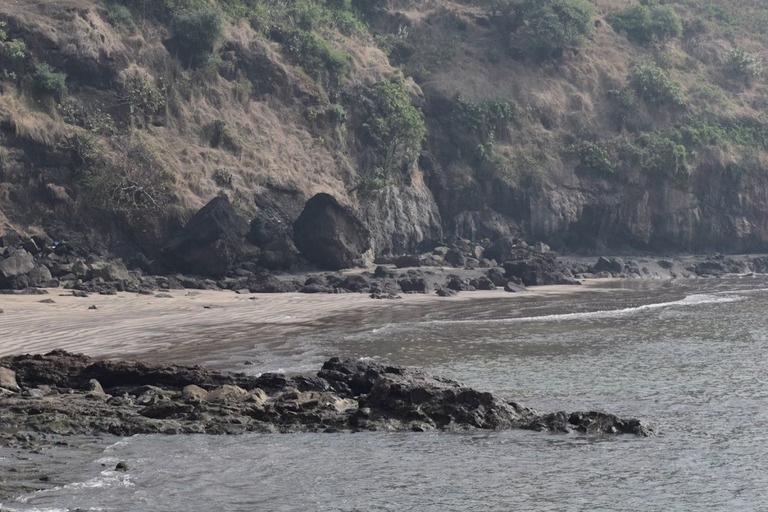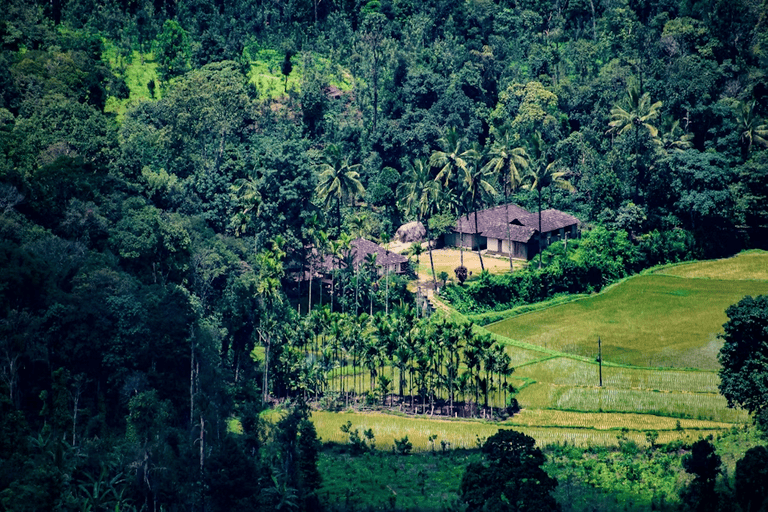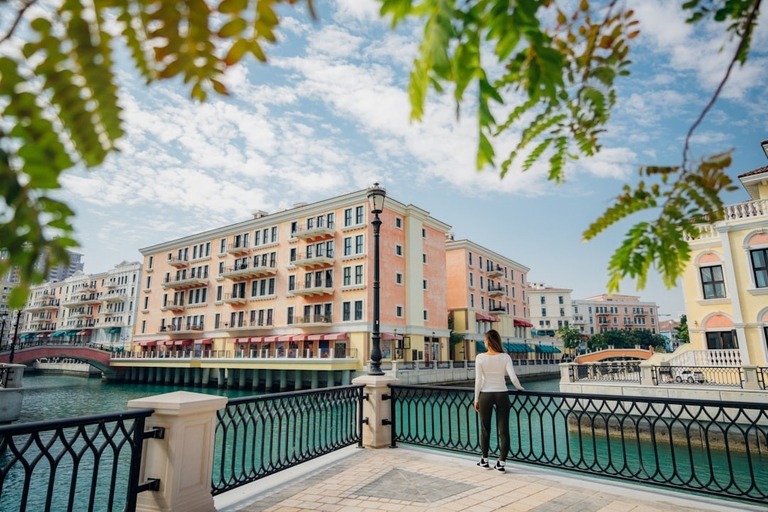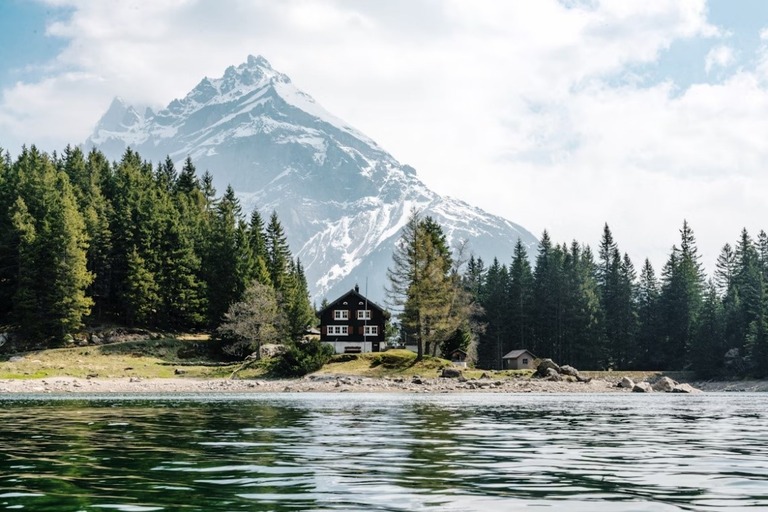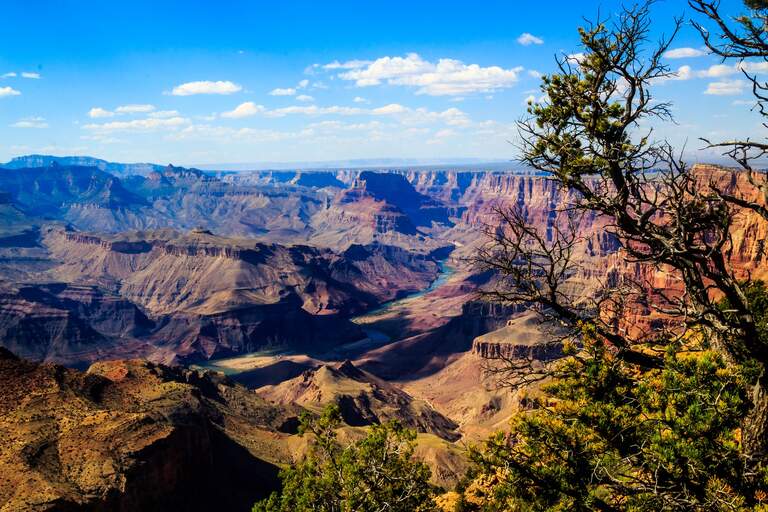
Hiking Tips for an Unforgettable Grand Canyon Adventure
Table of contents
“The American West is one of the most beautiful places to visit in America. One of the world’s greatest wonders lies within it: the Grand Canyon National Park. Although it is the most popular place, only 5% of visitors hike below the rim. While the views from the top are breathtaking, the sights within the canyon are even more incredible.”
As you descend, you will be surrounded by stunning beige and red rock layers. Each layer tells a story from millions of years ago. These limestone, sandstone, and shale bands cascade down the canyon walls like an ancient hourglass.
You should venture deep into the canyon to touch rock formations nearly 70 million years old. But be warned: this hike is challenging. With a descent of over 5,000 feet and summer temperatures often exceeding 100 °F, you must be well-prepared to tackle this journey through time.
What To Expect Inside the Grand Canyon?
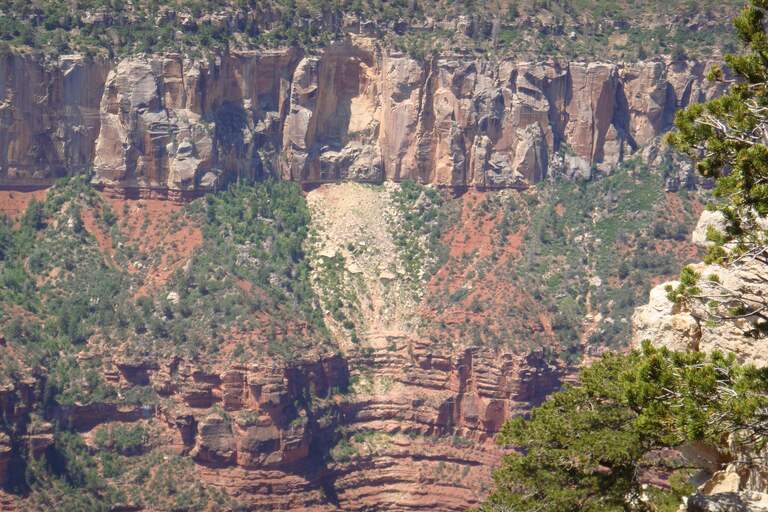
Inside the Grand Canyon
“The American West is one of the most beautiful places to visit in America. One of the world’s greatest wonders lies within it: the Grand Canyon National Park. Although it is the most popular place, only 5% of visitors hike below the rim. While the views from the top are breathtaking, the sights within the canyon are even more incredible.”
As you descend, you will be surrounded by stunning beige and red rock layers. Each layer tells a story from millions of years ago. These limestone, sandstone, and shale bands cascade down the canyon walls like an ancient hourglass.
You should venture deep into the canyon to touch rock formations nearly 70 million years old. But be warned: this hike is challenging. With a descent of over 5,000 feet and summer temperatures often exceeding 100 °F, you must be well-prepared to tackle this journey through time.
Why Should You Be Prepared Before Hiking Grand Canyon?
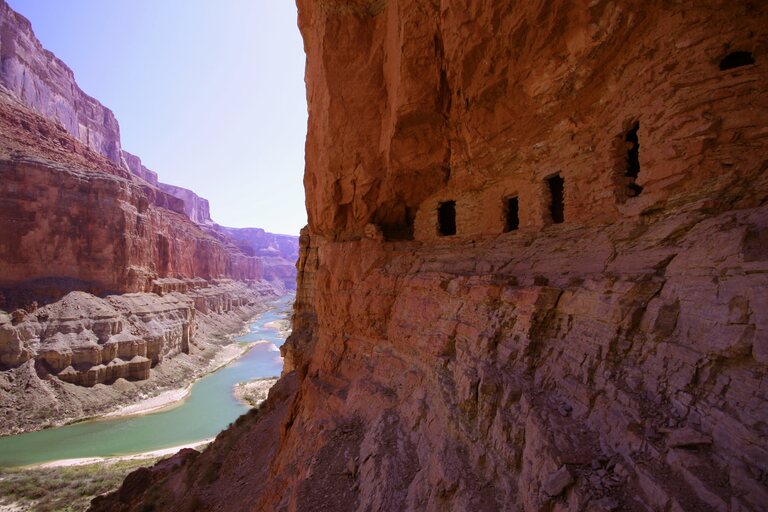
Grand Canyon lake
Many visitors treat the Grand Canyon as a quick stop, spending only 20 minutes to four hours there. However, a day hike to the bottom offers a unique view that most people miss.
If you have ever hiked in Arizona, you know how intense the heat can be. Temperatures vary with elevation and season. However, when most people visit in the summer, the inner canyon often exceeds 100°F, sometimes reaching 120°F. Moreover, there are 13-14 hours of sunlight each day, which can be overwhelming.
Most hikers use the South Kaibab and Bright Angel Trails. Although these trails are the most enjoyable ones among other trails, here people also suffer from heat exhaustion and dehydration.
The combination of high heat, drastic elevation changes, lack of cell service, and the need to follow Leave No Trace principles makes preparation crucial. By being well-prepared, you can safely enjoy the amazing experience of hiking the Grand Canyon.
Hiking Tips for An Unforgettable Grand Canyon Experience
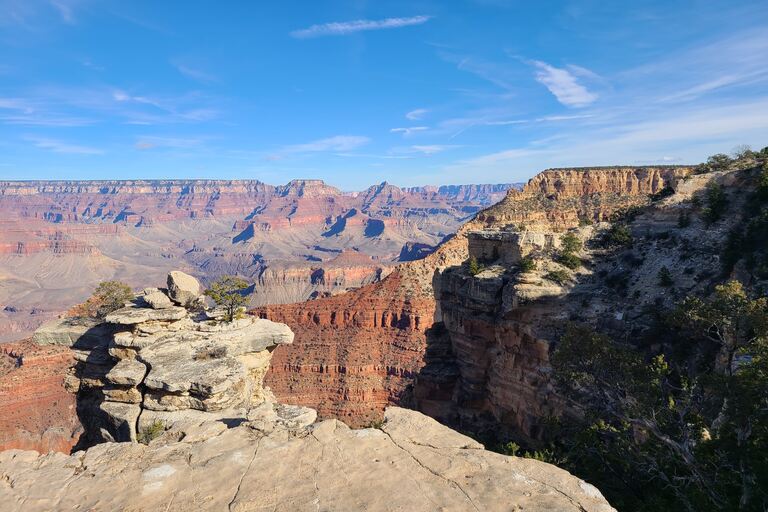
Grand Canyon Experience
Some of the hiking tips for an unforgettable Grand Canyon experience are:
#Tip 1: Start Early and Dress Smart
As mentioned above, the best Grand Canyon views are not from the top. You need to hike inside to appreciate its size and beauty. But remember, hiking here means going downhill first and then back uphill, which can be challenging.
The North Rim sits about 8,000 feet above sea level, and the South Rim is 7,000 feet. Hiking to the Colorado River means dealing with a big elevation change, usually between 5,000 to 6,400 feet. This can be grueling, especially in the heat.
Temperatures can reach 120°F at the bottom, much hotter than at the rim. To avoid the worst heat, start your hike early in the morning. Wear light, breathable clothing that covers your skin. Sun shirts, hats, sunglasses, and long pants will keep you cooler and protect you from the sun.
Plan for a check-in with yourself and your group after hiking 2-3 miles. This helps you assess if you should continue. Remember, the climb back up is much harder and takes longer than going down.
#Tip 2: Stay Hydrated and Prepared
Since 2010, the Grand Canyon has seen 134 fatalities, making it the national park with the highest death toll. Over 250 people are rescued annually, often due to medical issues like dehydration or cliff falls.
While these statistics may seem daunting, they underscore the importance of preparation, particularly regarding hydration. Dehydration and overhydration (hyponatremia) are common in the Grand Canyon, especially in hot weather.
Recognize the symptoms, including paleness, headache, nausea, and confusion. If you or someone in your group experiences these, seek help from a park ranger immediately.
Prepare by eating a hearty meal the night before and drinking plenty of water. During your hike, replenish electrolytes and carry emergency glucose tablets. In summer, bring at least one litre of water per hour of hiking and plan your water stops wisely.
Stay safe and hydrated to enjoy your Grand Canyon adventure to the fullest.
#Tip 3: Choose the Right Time and Trail
With 4.5 million visitors a year and 225,000 hiking below the rim, the Grand Canyon can get crowded, especially in summer. Most hikers use the Bright Angel and South Kaibab trails, as they are the only consistently maintained paths.
To avoid the heat and crowds, visit in spring (March to May) or fall (September to November) when temperatures are cooler. Winter hiking is possible, but be cautious of icy paths and note that the North Rim is closed.
Regardless of the season, weekdays are less crowded. Starting early also helps you beat the traffic and enjoy a quieter experience. Bright Angel Trail is a good choice for first-timers due to its water stations and restrooms. South Kaibab Trail is also well-maintained but has no water stations, so plan accordingly.
Remember, you might encounter mule trains on the trail. When you do, stay to the inside (away from the cliff) and follow the rider’s instructions. Exploring the Grand Canyon location with these tips in mind will make your hike safer and more enjoyable.
#Tip 4: Plan and Prepare Ahead
Plan ahead of beginning your Grand Canyon hike. First, study the trail map and note the mileage and elevation gain. Many hikers underestimate the difficulty of Grand Canyon hikes because the distances seem short. Remember, the steep terrain makes these hikes challenging.
Plan your restroom stops, as the steep drop-offs and crowds can make it difficult to find privacy. If you plan to camp overnight below the rim, reserve your campsite well in advance. Backcountry hiking and camping permits are required and should be obtained at least three months ahead of your trip, sometimes even a year in advance.
Also, note that there’s an entrance fee to the park in the summer. If you join a guided multi-day hiking tour, the guide service will handle permits and itineraries for you, making your experience smoother and more enjoyable.
#Tip 5: Packing Essentials
Having the right gear is essential for hiking the Grand Canyon. Here are some essential things you should consider bringing during your hike:
- Water & Salty SnacksPreparation will make or break your Grand Canyon National Park trip. Popular hikes like the South Kaibab Trail do not have water stations, so bring more than enough water to stay hydrated in the desert heat.The Grand Canyon is at a high elevation and is hot and dry. Therefore, water will not be enough for you. Pack snacks like peanuts, Pringles, and Gatorade. These snacks will give you the energy and electrolytes you need.If you are prepared with these essentials, you will experience a more comfortable and enjoyable Grand Canyon hike.Canyon hike.
- Sun Protection

Sun Protection
A wide-brimmed hat is essential for sun protection. Unlike a baseball cap, it provides better coverage and keeps you cooler. Any wide-brimmed hat will do, but consider one with ventilation for added comfort. Also, do not forget sunscreen, especially if you are wearing a T-shirt and shorts.
A T-shirt and shorts are fine for shorter hikes (3 miles or less). However, if you’re hiking longer distances, consider wearing long-sleeved shirts and pants for added protection against the sun and elements. Mule riders going to the bottom of the canyon must wear long sleeves and pants, but for day hikes, it’s usually not necessary unless you’re hiking over 3 miles round trip.
- Footwear
- They are lighter and more comfortable, especially for the uphill hike.Hiking shoes should be sturdy and durable. Therefore, consider getting a stride analysis at a store to find the best fit for you. On rocky trails, like those in the Grand Canyon, the difference in support can be noticeable. Having sturdy shoes will make you feel less impact from the rocks under your feet as it provides a more comfortable hiking experience.Invest in quality footwear and make your hike more enjoyable. You can reduce the risk of foot fatigue or injury.
- Hiking Poles
- For added stability and balance on your Grand Canyon hike, consider bringing hiking poles. They help distribute weight between your legs and arms, reducing strain and fatigue. Many hikers, including younger ones, use poles for support, especially on steep trails.When choosing poles, opt for adjustable ones. This allows you to customize the length for different terrains. Lengthen them for downhill sections to reduce the impact on your knees, and shorten them for uphill climbs to maintain proper posture and efficiency.Investing in hiking poles can enhance your hiking experience and make navigating the Grand Canyon trails safer and more enjoyable.
- GPS UnitCell service is non-existent in the canyon. For simple day hikes like Bright Angel and South Kaibab, a GPS unit isn’t necessary.However, for trails like Hermit and Grandview, where turnoffs aren’t well-marked, a map is essential. While some hikers prefer GPS units for added peace of mind, they’re not essential for these trails.If you’re considering a GPS unit, research different options to find one that suits your needs. Alternatively, stick with a reliable map for navigation.Remember, preparedness is key when hiking in remote areas like the Grand Canyon. Ensure you have the necessary tools to navigate safely and confidently.
#Tip 6: Stay Connected and Informed
Cell service below the Grand Canyon Rim is unreliable, making communication in emergencies challenging. Evacuations inside the canyon are limited to mule or helicopter during daylight hours, with the Park Service managing procedures.
To stay safe, carry a Garmin InReach or similar satellite communication device, especially for backcountry hikes. Emergency phones along main trails connect directly to the Park Service, while each campground has a medically trained ranger.
Inform the Park Service of your itinerary and expected return time. Also, share this information with friends and family. The more people know your plans, the faster help can reach you in case of an emergency.
By staying connected and informed, you can enjoy your Grand Canyon adventure with peace of mind.
#Tip 7: Keep Your Pets Away
While leashed dogs are allowed above the canyon rim to enjoy the vistas, pets are not permitted on hiking trails or into the canyon itself. These rules are strictly enforced, so it’s best to avoid any headaches by leaving your four-legged friends at home.
Whether you’re planning to hike the Grandview Trail or visit Ooh Aah Point, remember that pets are not allowed on the trails. Respect the park regulations and plan accordingly to ensure a smooth and enjoyable hiking experience for yourself and other visitors.
Whether you’re marveling at the geological formations, observing the diverse ecology, or immersing yourself in the rich history, the Grand Canyon promises a journey filled with wonder and discovery.
So, lace up your hiking shoes, pack your essentials, and embark on your adventure. With these precautions in mind, your trek through the Grand Canyon will be a memory to cherish forever.
And if you’re feeling adventurous, do not forget to visit the Grand Canyon Skywalk for an extra thrill! Book your America Tour package with Thomas Cook today and enjoy a stress-free vacation.
Table of contents
Trending blogs for you
Recommended Articles for you
Hotter Than Hot: Exploring India’s Hottest Destinations
Reading Time: 10 minutes 0 0 Exploring the hottest places in India reveals more than just extreme temperatures; it uncovers a rich tapestry of cultures, intriguing histories, and breathtaking landscapes. From the arid deserts of Rajasthan to the blazing plains of Uttar Pradesh, each […]
10 Best Places To Visit In July In India On A Budget
Reading Time: 11 minutes 0 0 July, with its refreshing monsoon showers, transforms India into a vibrant tapestry of lush greenery and spectacular landscapes. For those who wish to explore the beauty of this transformation without causing a dent in their wallets, there are […]
Top 10 Coldest Places In India You Must Visit This Winter
Reading Time: 8 minutes 0 0 As winter approaches, the quest for crisp air and snow-covered landscapes draws many away from India’s typically mild winters. Embrace the season by venturing into the country’s coldest regions, where each destination offers a unique blend of natural […]
12 Best Places To Visit In November In India In 2025
Reading Time: 8 minutes 0 0 November is a month of vibrant transitions in India, offering an array of travel experiences from the cool Himalayan foothills to the warm beaches of the south. If you’re planning your travel itinerary for November 2024, India presents […]
10 Stunning Places To Visit In October In India To Experience the Autumn
Reading Time: 11 minutes 0 0 10 Stunning Places To Visit In October In India To Experience the Autumn October marks a magical time in India when the monsoon rains have ceased, and the landscape bursts with vibrant colours, making it an outstanding month […]
September Travel Guide – 8 Offbeat Places to Visit in September in India
Reading Time: 4 minutes 0 0 As the monsoon starts to wane, September brings forth the vibrant palette of India with its pleasant climate and colourful festivals, making it an ideal time for offbeat travels. This guide delves into eight unique destinations across India […]
Explore Top Places to Visit in India this August
Reading Time: 11 minutes 0 0 August in India isn’t just about monsoon rains; it’s a month that opens up an array of travel possibilities across the country. From the cool hill stations to the less crowded beaches, the best places to visit in […]
10 Best Places to Visit in November Outside India on a Budget
Reading Time: 8 minutes 0 0 As November rolls in with its mild weather and the promise of new experiences, many Indian travellers start looking for the perfect overseas getaway that doesn’t break the bank. If you’re planning to explore new cultures, cuisines, and […]
Top 10 Best Countries to Visit in October for Stunning Autumn Views
Reading Time: 9 minutes 0 0 Top 10 Best Countries to Visit in October for Stunning Autumn Views As October rolls in, so does the magical palette of autumn, transforming the landscapes of various countries into a vivid mosaic of colours. The crisp air […]
A Simple Explanation of Currency Pairs for Forex Beginners
Reading Time: 4 minutes 0 0 The foreign exchange market, or Forex, is the largest financial market in the world, with trillions of dollars traded daily. For beginners, understanding the basics is crucial to navigating this dynamic market. One of the most fundamental concepts […]
Which Currency is Best to Use in Dubai?
Reading Time: 4 minutes 0 0 Dubai, one of the world’s most vibrant and luxurious destinations, attracts millions of tourists and business travellers each year. Known for its towering skyscrapers, world-class shopping malls, and rich cultural experiences, Dubai’s allure often raises a common question […]
Step-by-Step Guide to Reloading and Unloading Your Forex Card
Reading Time: 5 minutes 0 0 A Forex card is an indispensable tool for international travellers, offering a secure, convenient, and cost-effective way to carry foreign currency. Whether you are a frequent flyer, a student studying abroad, or simply on holiday, a Forex card […]
5 Best Places to Visit in August Outside India in 2025
Reading Time: 9 minutes 1 0 As August approaches, many travellers seek destinations that offer a change of pace from the usual summer heat. Whether you’re escaping the warm Indian climate or looking to experience unique cultural events, August presents the perfect opportunity for […]
What is the Interbank Rate? A Guide to Foreign Exchange Pricing
Reading Time: 4 minutes 0 0 The interbank rate is a cornerstone of global finance, particularly in the foreign exchange (forex) market. It represents the rate at which banks trade currencies with one another, forming the foundation for exchange rates that individuals and businesses […]
8 Best Countries to Visit in July: Top Picks for Your Summer Getaway
Reading Time: 8 minutes 0 0 July is a fantastic month for travel, with the warm embrace of summer casting a golden glow over many of the world’s most captivating destinations. The longer days and vibrant energy make it the perfect time to explore […]
Understanding Foreign Transaction Fees and How to Avoid Them
Reading Time: 4 minutes 0 0 When travelling abroad or shopping online from international websites, one cost often overlooked is foreign transaction fees. These fees, while seemingly small, can add up quickly, increasing the total cost of purchases made in a foreign currency. Understanding […]
15 Best Places To Visit In April In India For An Exciting Spring Break
Reading Time: 9 minutes 0 0 April in India is a month of vibrant transitions and a wonderful time to explore its diverse landscapes. With the harsh winter receding and the scorching summer yet to set in, conditions are just right for discovering the […]
10 Best Places To Visit In May In India 2025 For A Thrilling Summer Escape
Reading Time: 10 minutes 0 0 As the summer sun brightens the Indian landscape, May is a wonderful time to explore the beauty and diversity of this vast country. From the cool hill stations in the north to the lush greenery of the south, […]
6 Budget Friendly Places to Visit in May Outside India
Reading Time: 8 minutes 0 0 Travelling outside India doesn’t have to be expensive! With a bit of planning, you can explore incredible international destinations on a budget while still enjoying unique cultural experiences and stunning landscapes. From the ancient temples of Southeast Asia […]
Why These Are the Best Countries to Visit in February: Travel Recommendations
Reading Time: 12 minutes 1 0 February may not be the first month that comes to mind for travel, but it’s an underrated gem for those seeking unique experiences without the crowds of peak tourist seasons. As the world transitions between winter and spring, […]
 18002099100
18002099100
